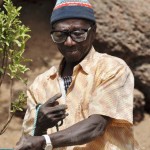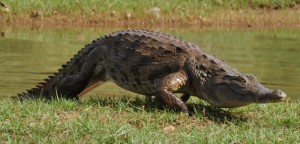 The annual Dakar Rally covering some 10,000km in around three weeks across the Sahara and West Africa ending in Dakar had first made me aware of Senegal. Our truck arrived in Dakar on March 12 ending our 8000km (estimate) overland journey through nine countries in West Africa in 68 days. I shall always remember my stay in Senegal as I got lost in the bush in the middle of the night and caught the worst cold in my life. These mishaps have not ruined my holiday and I have sweet memories of sensual Dakar, St-Louis and the Island of Goree.
The annual Dakar Rally covering some 10,000km in around three weeks across the Sahara and West Africa ending in Dakar had first made me aware of Senegal. Our truck arrived in Dakar on March 12 ending our 8000km (estimate) overland journey through nine countries in West Africa in 68 days. I shall always remember my stay in Senegal as I got lost in the bush in the middle of the night and caught the worst cold in my life. These mishaps have not ruined my holiday and I have sweet memories of sensual Dakar, St-Louis and the Island of Goree.
Background
Senegal with an area 196,192 square kilometres and a population of about 13 million, has played an important part is the history of French West Africa. Unlike Mali, Benin or Ghana, it has no legendary kingdom. Today, it has several main ethnic groups. The Wolof comprises 43% of the population, Fula 24%, Tukulor 10 %, Serer 14% and Diola 5%. 90% of the population is Muslim.
History
In 1443, Portuguese explorers arrived at the mouth of the Senegal River and later settled on the Island of Goree. In 1659, the French developed a trading station in St-Louis and secured Goree in 1677.
France banned slave trade in 1815. The French aimed to develop new sources of wealth. Plantations particularly groundnuts were established and expanded and Senegal became the gateway to the large territory of French Africa. At the Berlin Conference 1884-85, the greater part of West Africa was allocated to France. French West Africa stretched from the Atlantic to present –day Niger.
The whole region was given independence on June 20, 1960 and Senghor became first president. Senghor and his party Union Progressiste Senegalaise formed since 1957 built the ideology of African socialism. In 1974, a cautious new liberalism was initiated and Party Democratique Senegalaise (PDS) led by Maitre Abdoulaye Wade was formed. In January 1981, Senghor became the first African president to retire voluntarily and passed the presidency to Abdou Diouf, his vice-president. Senegal joined with The Gambia to form the nominal confederation of Senegambia on February 1, 1982. But the union was dissolved in 1989.
Serious political and social unrest followed the 1988 election and Diouf declared a state of emergency. Abdoulaye Wade who was defeated at the election was arrested. In 1995, Wade and six PDS colleagues were invited by Diouf to take up cabinet posts in the national government. Wade finally won the presidential election in 2000, re-elected in 2007 and has remained in power since.
Senegal has faced many challenges internally and externally. The Senegal-Mauritania crisis of April 1989 to October 1990 triggered off by a dispute on the border resulted in mistrust between the two neighbours for the next decade. The separatist feeling in Casamance south of the Gambia has persisted since 1980s. Things have calmed down since the signing of a peace treaty with the rebels in 2004. But some remote parts of BasseCasamance remain no-go zones because of rebel activities and/or land mines.
Economy
The country’s GDP (official exchange rate) was US$14.7 billion (2011 est). The GDP (PPP) and GDP per capita (PPP) was US$25.4 billion and US$1900 (2011 est). The economy is dominated by fishing, tourism and groundnuts. Unemployment is a serious problem and the rate was estimated to be 48% in 2007. One of the biggest issues is the fleeing of Senegalese to Europe for better job opportunities. But these rickety wooden fishing boats regularly capsize or sink before they reach the Canary Islands.
Senegal is rich in tourism resources. It has six World Heritage Sites namely the Island of Goree, the Niokolo-KobaNational Park, theDjoudj National Bird Sanctuary, Island of St-Louis and the Stone Circles of Genagambia, Saloum Delta.
Day 58 (Friday, March 2): Mali –Kidira, Senegal (260 km; 6hrs)
On our way to the Senegalese side, we drove some 250km to Kayes to visit a fort and then crossed the border without problem. We arrived at the Senegal side around 5pm. There was great excitement when we spotted Rick, our old mate who left the group at the end of the Doula to Accra trip to return to the UK. As his ski trip had fallen through, he decided to fly to Senegal to meet up with Jess (and us!) again. How romantic!
While Mike took our passports to the immigration office, we stayed on in the truck and Rick gave us all a big hug! He has been popular not only because he is a competent and passionate cook. He is kind, considerate and most helpful.By the time Mike and Ant got all the formalities done, it was about 6:30pm. They raced to find a campsite off the main highway. I set up my tent close to the truck and next to Peter and Mary.
My cold got worse. I had a fever, a horrible cough and could hardly breathe. My bones were also aching. I had to get up around mid-night to go to wee.I felt so uncomfortable that I had to rush out for the second time. I did not put on my glasses and as my torch did not work, I left my tent without it. I thought I would have no problem in finding my way back. I was wrong!
I had no idea when I left my tent or how long I strayed in the bush before sunrise. A few things went wrong. First, there was no moonlight and I had no torch. Second, I left my glasses in the tent and could not see. I could not find the truck. Third, I was confident in finding my way back to my tent without aid and did not want to disturb others from their sweet dreams. Hence, when I walked past Mike’s tent at the far end of the camp site, I did not stop to seek help. Instead I walked on (perhaps on the opposite direction thus leading me further away from the camp site.) For the first time in my life, I got lost in the bush in the middle of the night!
I tried to keep a cool head. It was a chilly but not cold. There are sharp thorns in the bush and I had to move slowly and steadily. I tried to keep warm as I already had a bad cold. I must not fall and break my neck or have myself cut by the thorny bush. I vaguely saw headlamps of trucks in the distance. Hence, I walked carefully towards the light and later found myself next to the highway. I sat down and did some exercise to keep myself warm. I was tired but there was nowhere I could sleep! I started to head back to the bush when the sky brightened up. I might have walked for over an hour without any sight of the camp site. I decided to return the highway (RN1) and sat by the road mark “636D”.
Dozens of trucks and buses drove past. But none stopped. I had seen one motorbike. When I tried to stop the bike, it was gone. As I had no watch, I did not know how long I sat there. But I was sure that when Mike and Ant found me missing, they would look for me and come to my rescue!
The sun was getting hot and I held my head down in the shade! Then Ant suddenly appeared on the horizon. He said that they only noted my disappearance when I did not turn up for breakfast at 7:15am. He asked bus/truck drivers whether they had seen me along the road. They said ‘yes’ and he was relieved. But he took some 40 minutes to reach me and was amazed how far I had walked during the night!
What had happened? I still could not understand how I could have walked so far in the dark! Was it because I was sick and got disorientated? Anyway, it is a mystery!
But it has taught me a few valuable lessons. First, I should always have a good torch/headlamp. Second, I must have my glasses. Third, even if I think I may be out for a moment, I should keep myself warm. The one minute can turn into hours and days! Fourth, in case of doubt, I should stop and wait for the search party! Or I head to the main road where I can be spotted easily!
Day 59: Kidira-Tambacounda–Niokolo-Koba National Park (250km; 6 hrs)
The group must have spent over an hour looking for me. Then one of the search parties with Angelito and Mary got lost. The group had to find them before picking me and Ant up from RN1. All these dramas were over when I was back on the truck around 10am. I became a laughing stock!
My temperature had gone over 38 C. I decided to take a malaria-test at Tambacounda. This hospital is very basic and I had to wait 20 minutes before making payment for a test. I was relieved when the doctor told me that I had no malaria. But as I still had a temperature, he gave me a prescription. But as the pharmacy at the hospital did not have the drug, I had to wait for the truck to pick me up before getting the drug from a pharmacy in town.
It was about 40C. I was hot and exhausted. As the truck headed off to the national park right away, I did not get my medication till I was back in town a couple of days later.
The Niokolo-Koba National Park covers an area of over 9,000 square kilometres of savannah, forest and swamp. We took two hours to get to the Park entrance and almost another two hours to arrive at Hotel de Simenti. As I need a good rest, I took a room for CFA15000 a night. This is the best decision I have taken on this trip. I coughed so badly that even Gary and Mary whose room was next to mine heard me coughing throughout the evening.
Days 60 & 61: Niokolo-Koba National Park
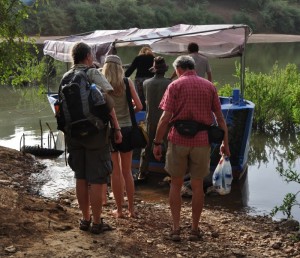 I was on cook duty with Mary and Christian on Day 60. As I had a cold, Rick volunteered to take my place. Mary would not even allow me to wash the dishes in fear that I would spread the germ. I took a boat trip in the morning and saw some crocs and birds on the Gambia River. But the engine noise was too loud and destroyed the tranquility and atmosphere. I think they should use a canoe or smaller boat and row manually.
I was on cook duty with Mary and Christian on Day 60. As I had a cold, Rick volunteered to take my place. Mary would not even allow me to wash the dishes in fear that I would spread the germ. I took a boat trip in the morning and saw some crocs and birds on the Gambia River. But the engine noise was too loud and destroyed the tranquility and atmosphere. I think they should use a canoe or smaller boat and row manually.
Originally we would spend two nights in the park. But as one of the suspensions of the truck was broken, Mike and Ant had to spend an extra day to fix it. They first took off the wheels, removed the broken piece and replaced it with a spare one. The temperature was well over 40C and they had a tough time! They were all covered in grease and sweat and were relieved when the truck was ready for the journey. I spent most of the time resting in my room. Good for me!
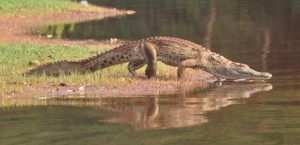 |
 |
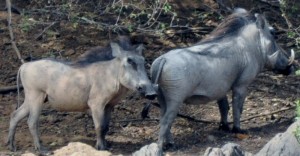 |
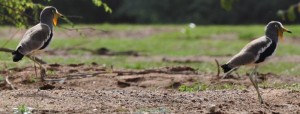 |
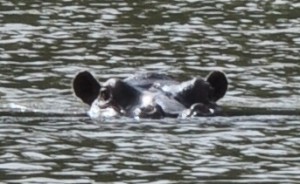 |
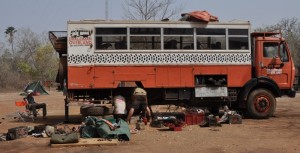 |
Day 62 (Tuesday, March 6): Niokolo-Koba National Park –Tambacounda, Senegal – Basse, The Gambia (150 km: 6hrs)
We set off early and spent over an hour in Tambacounda again. There was a small problem with the clutch and Mike and Ant spent an hour to fix it on the way to the border with The Gambia. Then we drove on bad dirt road for over an hour. Mike got our passport stamped and we drove on for a while. There seems to be no clear boundary and I suddenly saw a tin board with the word “The Gambia” on it. So we are in The Gambia around 5pm and bush camped close to Basse, near the border. (To continue in Senegal Part 2).


